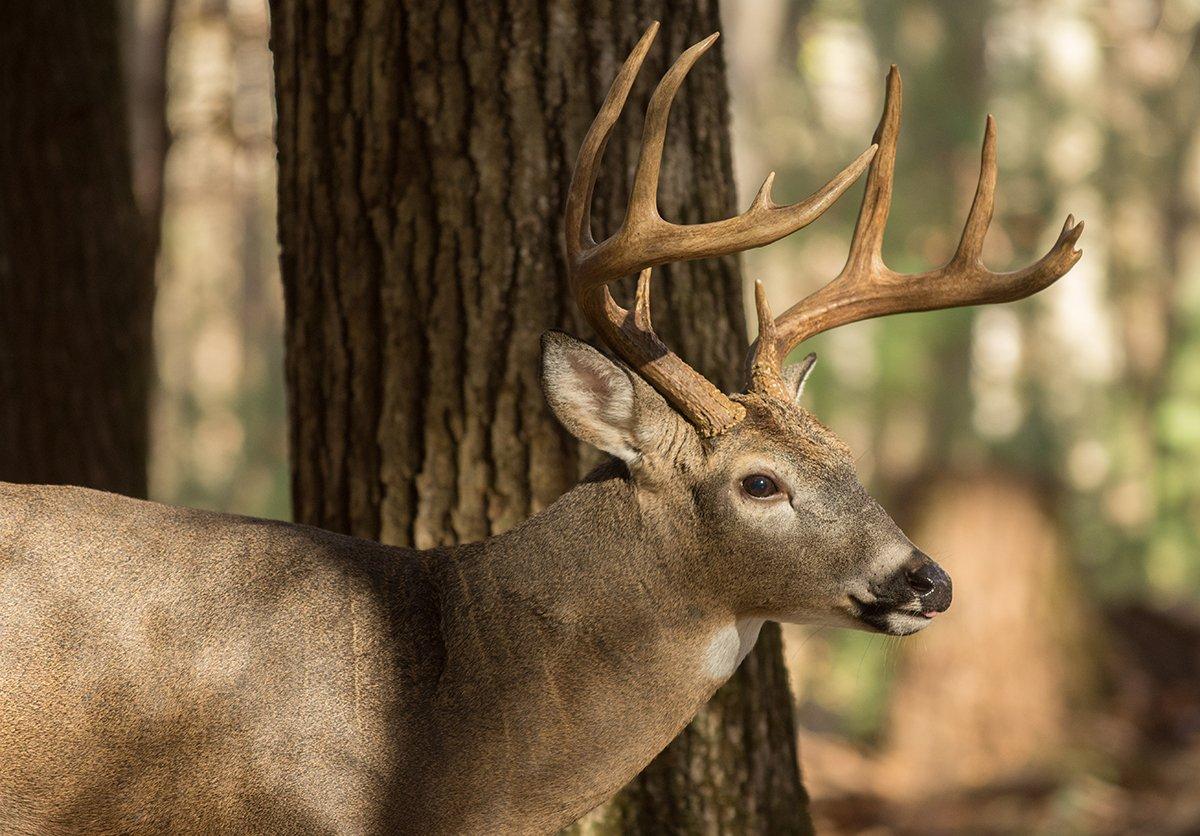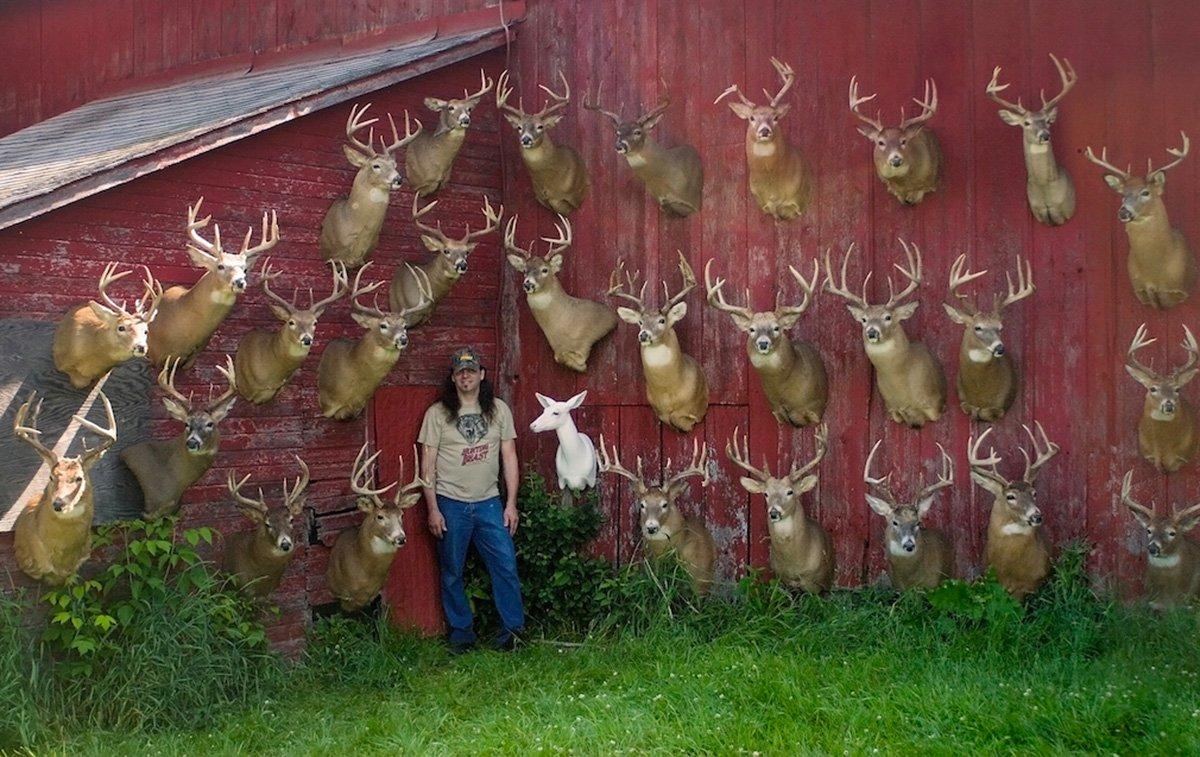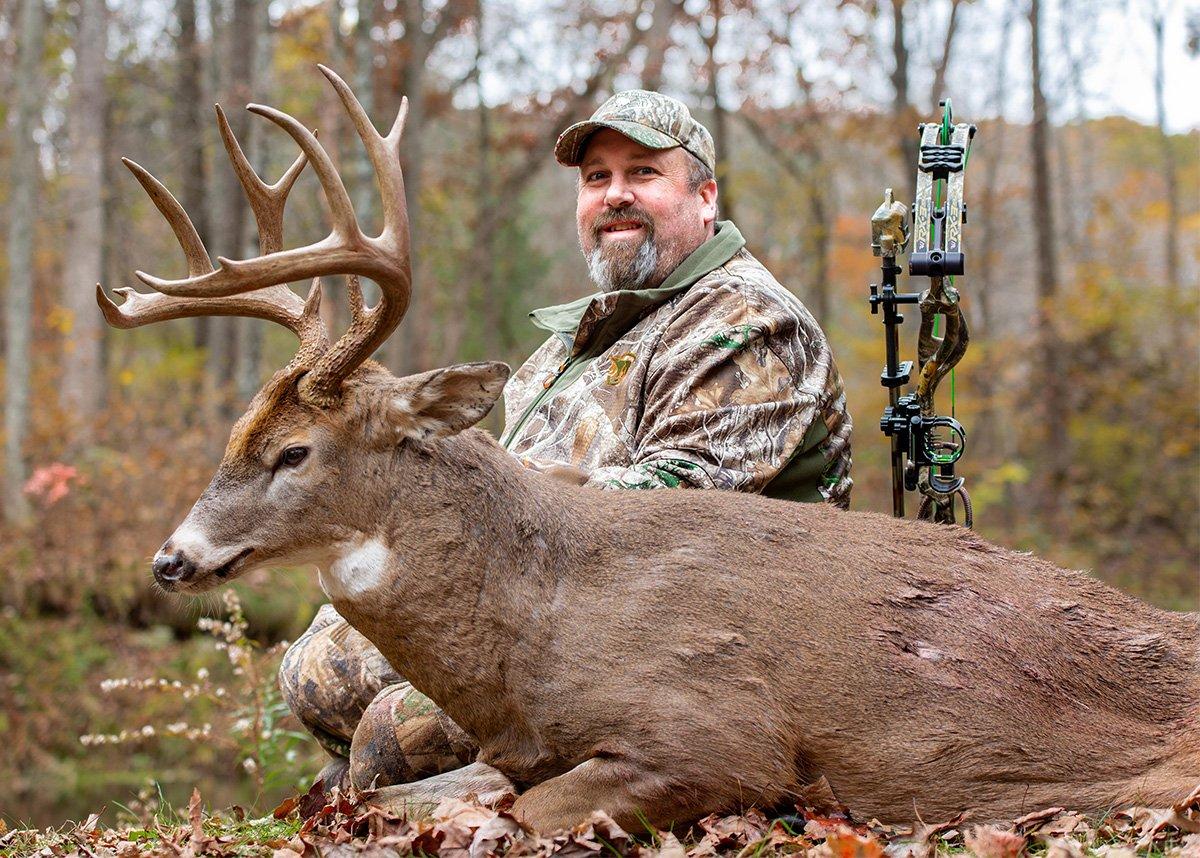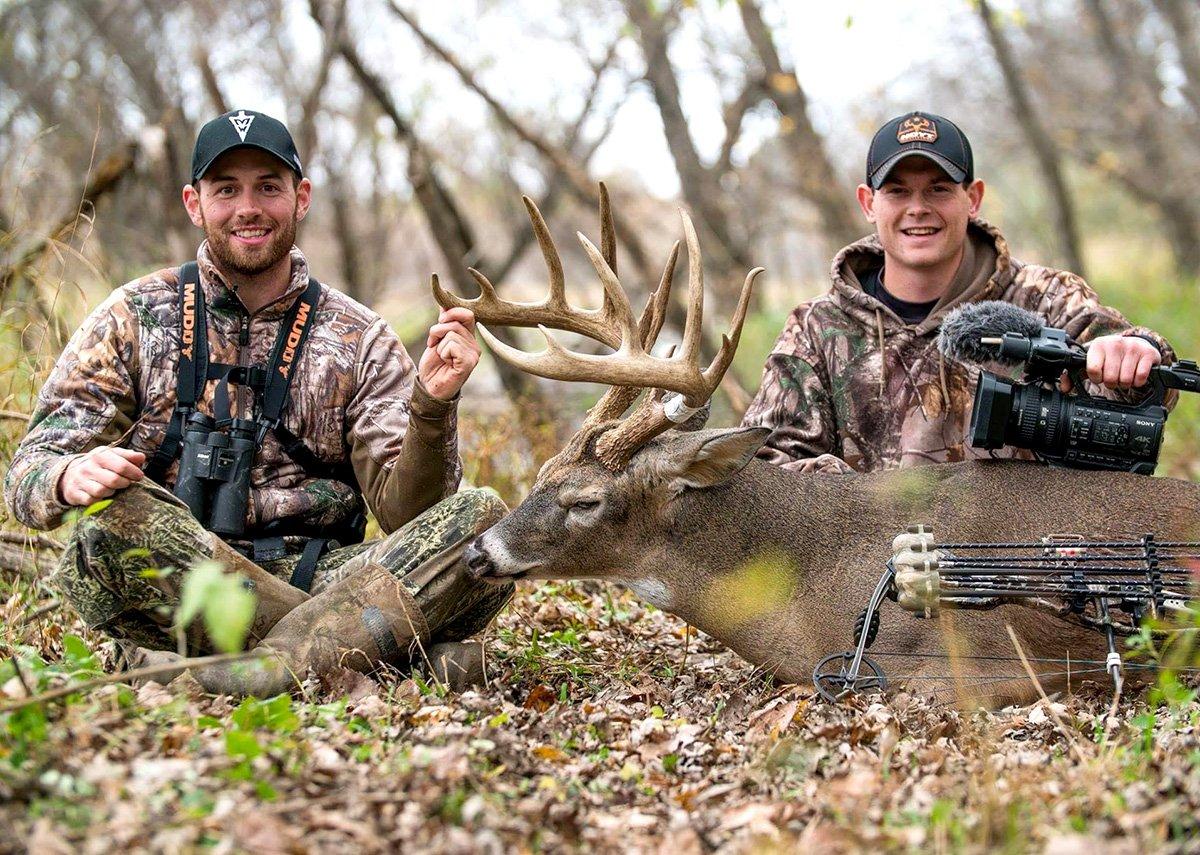Hunting a buck where he sleeps is risky, but it's also one of the best ways to kill him. Here's how to pull it off
Just a few days ago, I slipped into a bedding area, climbed a tree, and settled in for the last few hours of daylight. Right after sunset, I watched as my No. 2 target buck rose from his bed a mere 50 yards away. That buck stayed within a few yards of it until legal light ended, and then walked off toward a destination soybean field.
Although I didn't tag him that day, I slipped out with him none the wiser, and I plan on returning soon to kill that buck in the same spot. For years, many whitetail experts have cautioned against disturbing bucks in their bedding areas. But you're out there to hunt them, and the secret is out among many true big-buck killers: If you want to punch a tag, the bedding area is the place to be.
Understand Buck Bedding Areas
There is no place a giant buck is simultaneously more secure — and more vulnerable — than in its bedding area. For hunters who know how to hunt in and around these, it's a mature whitetail's kryptonite. And it's an incredible feeling when you climb a tree, settle in, and watch a buck stand up in its bedroom. Slipping in that tight is no easy task, and it's not advisable all the time. But when it works, it's pure adrenaline.
The first step to hunting buck bedding areas is recognizing them. Understand the types, including daytime and nighttime beds. The former offer significant sensory defenses within security cover. The latter are usually on the edges of food sources.
There are buck beds and doe beds. Even these break down into subcategories, such as single or doe family groups, and single or buck bachelor groups. Doe groups primarily rely on their eyes for safety when bedding. They all look in different directions. Buck bachelor groups do the same.
Mature loner bucks can't, so they bed with the wind at their back and eyes scanning downwind. As a result, they tend to change positions as the wind shifts. This habit can create one oversize bed, but it often results in clusters, ranging from four or five to 15 or 20. Areas worn down to the dirt, or spots with white belly hairs, indicate recent, and frequent, usage.
Time Your Searches
Finding beds should be done long before deer season. You can look now if you've never set foot on the property or just haven't had scouting time, but you'll apply much less pressure during the postseason. Dan Infalt of The Hunting Beast and Aaron Warbritton of The Hunting Public conduct most of their searches in late winter and spring.
Most of the time, I'm scouting in the springtime, Infalt says. After a while, you can look at the terrain and just know where they're going to be. When I look at a property, 95% of it is where I don't want to be. I'm looking for the spots where no one looks. Sometimes it's right beside the road. Sometimes it's remote. But it's rarely in the middle of the woods or on the edge of a cornfield.
On private lands, the best bedding-area hunts are architected. Creating, enhancing, and optimizing bedding-area edges for slipping in undetected is critical.
When I set up properties, I locate where those bedding areas are, says Art Helin, co-host of Own the Season. Then, I think about how to get from point A to B on different winds. I'm creating some type of cover along trails to improve access routes. Standing corn, hinge cuts, and other methods help with this. A lot of times, I'll use this cover to push closer to bedding areas.
Locate Buck Bedrooms
So, where to find these daytime haunts? Generally, it depends on the type of terrain, but deer prefer grassy, stemmy, stalky areas over timber. Oftentimes, we find the biggest bucks bedded out in tall grass with high stem counts, marshy areas, and other areas without trees to get stands in, Warbritton says. A mature buck bedding area needs good escape routes to get to other secure locations on the property. Oftentimes, they'll bed along a barrier, such as a patch of thick brush or blow-down timber, and face an open area.
Other places to consider include benches, CRP, cutover timber, deep timber, ditches and drainages, hubs, islands of cover, leeward ridges, oxbows, peninsulas, ridge points, swamps, thickets, overlooked pockets of early successional growth, and anything offering edge habitat.
Someone might read that list and say, Well gee-whiz, sounds like they'll bed about anywhere. But the truth is that most properties — especially smaller ones — may only offer two or three of these features, if that. Furthermore, just because features are there, it doesn't mean bucks will use them. There are other boxes to check, such as nearby water, winding advantages, lack of human intrusion, and more.
(Don't Miss: 8 Deadly Ambushes to Try This Bow Season)
Regardless of the terrain, each bedding area sees a peak usage window. Deer generally don't use the same sites year-round. [One] next to an oak flat is there because of the acorns, Infalt says. Early season is the time to hit that. If you have bedding areas torn up with rubs, you can bet that's going on during late October. You kind of get a feeling for the timing these bucks are using these areas. Then you move in accordingly.
Timing aside, Infalt and Warbritton both emphasize finding security cover that doesn't get much, if any, human scent. That might be right beside a road, or 2 miles deep in the thick stuff. And don't forget just how important escape routes are. Once you really think about how escape routes are situated, you'll understand why they're there, Warbritton says. Oftentimes, they can smell, see, and hear danger coming before it gets there.
Once you locate beds, mark them on a map, or in an app, such as onX. When possible (and legal on public land) it's best to hang stands for specific beds long before you hunt them. It's difficult to hang a set silently with a buck bedded less than 100 yards away. Come time to hunt, you can consider your spots, check the wind, and determine which are huntable on a given day.
Know When to Hold Off …
There are times when you should stay out of bedding areas. It's a high-risk, high-reward strategy, and not all bedding areas are laid out in a huntable manner. On some properties, deer bed in layers, with does, fawns, and younger bucks in the lesser bedding, and mature deer taking the best spots. Getting close to these older deer means getting past others, and that's a dadgum challenge.
Aside from layer bedding, sometimes these buck beds truly are impenetrable. This is especially true for those that take advantage of topography, such as ridges and benches that are more difficult to approach without being seen. It's also impossible to get close without good entry routes, and it's very difficult to do it a second time without quality exit paths. That's where Helin's off-season planning comes into play — constructing good entries and exits is critical for long-term success.
Weighing mornings versus evenings, pushing in for an afternoon sit is sometimes impossible, as the deer are already there. Slipping in several hours before daylight is a little easier because deer generally aren't back yet. Even then, mature bucks often circle in from downwind upon return, so that's a challenge, too. Windier days make it a little easier.
A lot of the really big bucks I've shot, I've observed them get up out of their bed, and move to me. But by the time I shoot them, it's closing time. And some of those have been during peak rut. Think about that. A guy doesn't have a chance if he's 200 or 300 yards back. — Dan Infalt
I love high winds, Warbritton says. Anything over 10 mph helps tremendously getting inside that bubble, morning or evening. When it's dead calm, it's difficult to get in there as tight as you need to be. Wet conditions help, too.
There are a few more cases in which you should stay out of the bedroom. If deer are moving lengthy distances in daylight, there's no reason to risk it. Simply back off the beds a bit. Also, if you have reason to believe deer will move better in the coming days, hold off. If I have three days to hunt, and I know a cold front is coming on the second day, I won't go in there on the first, Warbritton says. If I know it's a great spot, I might just sit observation the first evening, or go get aggressive on a different bedding area.
And obviously, if you only have one small place to hunt, it's better to hunt conservatively (farther from bedding areas) than to play the aggressive card. The next best thing is hunting staging areas between bedding, food, and water.
… And When to Push In
There are plenty of reasons to greenlight a bedding-area hunt. To begin, some bucks just don't leave the security of their beds until after dark. They might move 30, 40, or 50 yards before legal light ends, and that's it. Obviously, odds of an encounter increase when you get close enough to intercept that movement.
A lot of the really big bucks I've shot, I've observed them get up out of their bed, and move to me, Infalt says. But by the time I shoot them, it's closing time. And some of those have been during peak rut. Think about that. A guy doesn't have a chance if he's 200 or 300 yards back.
Sure, a mature deer might make mistakes a few days per year, but odds are you won't be hunting when it does.
Let's get real, if you're hunting pressured land, a 6 1/2-year-old deer didn't get to that age by wandering around in daylight, Infalt says. In November, I can't walk around the woods without walking under a stand. How could a buck do it? Even when hunters kill bucks over food, generally their beds are close.
Therefore, create opportunities by pushing closer. If you've patterned a buck — by placing cameras around the perimeter (not within the bedding area) — it's especially important to do this before a change in food sources, other hunters, or the rut carries that deer elsewhere.
Plus, if you have limited time to hunt, and everything else lines up in your favor, getting aggressive offers higher odds. Some people hunt 40, 50, or 60 days each fall. In which case, it's easier to sit back and be more conservative, Warbritton says. But most people don't have that kind of time. If you only have a few days to hunt, don't you want to hunt deer where they are during the day?
(Don't Miss: Why Windy Days are Great for Deer Hunting)
Of course, you need cover to conceal your approach visually, and wind to cover you audibly. If these two things align, and you can slip into a stand location from downwind, get in there and get it done.
Move In for the Kill
So, you've decided to go for it, and it's time to make a move. What next? Careful, meticulous execution.
In open country, I prefer to glass food sources early in the day to see where deer go back to bed, especially if I don't have trail cameras deployed. This tells you if a buck is in a given bedding area and provides a guestimate of its whereabouts.
Once you're ready to move, use the quietest gear available. Wear clothes with soft material (think opposite of most rain gear). Pad metal contact points on all equipment, such as safety harnesses and treestands.
Speaking of stands, while climbers can be stealthy, I'm not a fan of these for hunting close to known buck beds. One slip-up and deer scatter. A stick breaking is one thing. A metallic or other foreign sound is quite another. Because of this, pre-hung treestands in spots you found during the off- or preseason are your best bet.
Once on the property, the first order of business is checking the wind. Chart an entry route based on that. If that path also provides visual barriers all the way to the stand location, you're golden.
Property knowledge is important. Knowing every ditch, drainage, and roll in the terrain can help you slip in undetected. Move extremely slowly when approaching or departing a bedding area. Make no noise. Glass as you go. Stay sharp at all times.
Be cautious in that last couple hundred yards, Warbritton says. They're bedded in positions where they can see, smell, and hear you coming. It's step by step, easing in there as slowly and quietly as possible. If you break a stick, that's fine. Deer hear that all day. But you can't snap a stick and continue trudging along.
The final yards to your stand location are the most critical and can take an hour or more to cover. So, it begs the question, how close is too close?
It's how close can I get without screwing it up, Infalt says. If it's an area where you can't push it, I might set up farther back. In swampy areas and marshes, I'm usually 75 to 100 yards off a bed. In forested terrain, I'm usually back 100 to 200 yards. I'm getting as close as I can without them seeing, smelling, or hearing me.
Even before walking in, determine an exit strategy. If you can't get back out without disturbing deer, it'll be good for only one sit. Spook deer, and that bedding area is potentially a bust. (More on that later.)
But don't immediately count yourself out if a wrong step sends a buck packing. Good buck bedding areas serve a purpose: keeping tenants alive. So, don't be surprised if a buck gets bumped from its bed, then returns. You just might get a second chance.











